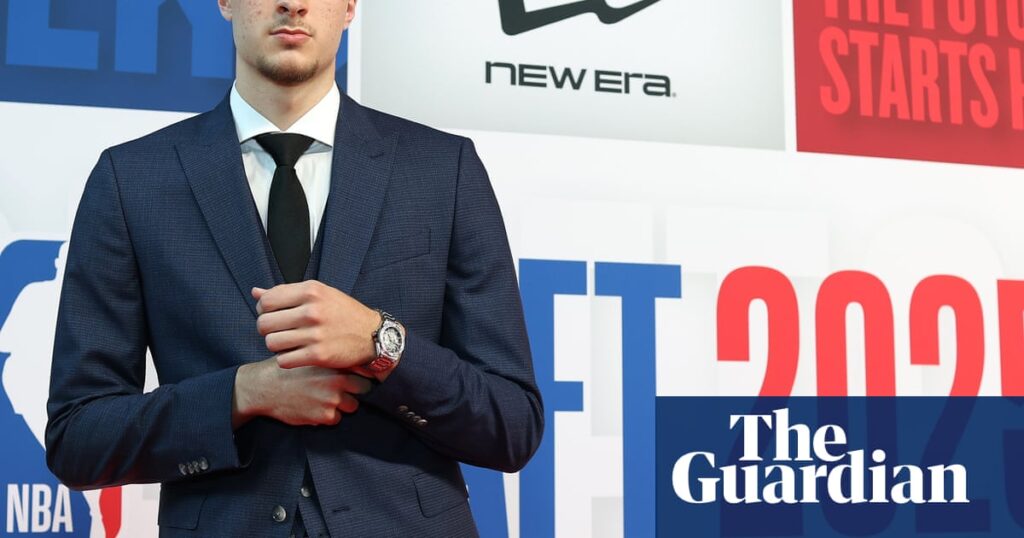
The Dallas Mavericks made a move anticipated by many on Wednesday night, selecting Cooper Flagg as the No. 1 overall pick in the NBA draft. The decision was met with enthusiasm, as Flagg, a standout forward from Duke University, expressed his excitement surrounded by family. “I’m feeling amazing. It’s a dream come true, to be honest,” Flagg remarked. “I wouldn’t want to share it with anybody else.”
Flagg’s selection follows an impressive single year at Duke, where he cemented his reputation as one of the nation’s top college players. His performance was a key factor in Duke’s journey to the NCAA Final Four, boasting averages of 19.2 points, 7.5 rebounds, 4.2 assists, 1.4 steals, and 1.4 blocks per game. His accolades include the prestigious Wooden Award and ACC Rookie of the Year.
Flagg’s Rise and the Mavericks’ Strategic Move
The Mavericks’ decision to draft Flagg was largely expected after they secured the No. 1 pick in the draft lottery, overcoming significant odds. The selection aims to placate a fanbase still reeling from the controversial trade of superstar Luka Dončić to the Los Angeles Lakers earlier this year. The 18-year-old from Maine is seen as a promising asset to the Mavericks’ roster.
Standing at 6ft 8in, Flagg’s versatility and skill set are anticipated to fill the void left by Dončić. His ability to perform in high-pressure situations was evident when he set an Atlantic Coast Conference freshman record with 42 points against Notre Dame.
Historical Context and Draft Comparisons
This marks the second time in franchise history that the Mavericks have held the No. 1 overall pick. The last occasion was in 1981, when they selected Mark Aguirre from DePaul University. The team hopes Flagg will have a similarly transformative impact on their fortunes.
The San Antonio Spurs selected Rutgers point guard Dylan Harper with the second overall pick. Harper, the son of five-time NBA champion Ron Harper, will join forces with French sensation Victor Wembanyama, suggesting a potential resurgence for the Spurs in the Western Conference.
Draft Surprises and Notable Picks
The Philadelphia 76ers’ selection of Baylor’s VJ Edgecombe at No. 3 was met with enthusiastic applause from fans at Barclays Center in Brooklyn. Edgecombe’s explosive athleticism and potential have made him a player to watch.
Meanwhile, the Charlotte Hornets picked Kon Knueppel, another Duke player, at No. 4, while the Utah Jazz selected Ace Bailey at No. 5. Bailey, a top prospect from Rutgers, had been a potential candidate for the 76ers’ pick but ultimately found his place with the Jazz.
By the Numbers: First-Round Picks
- Dallas Mavericks – Cooper Flagg, forward, Duke: Averaged 19.2 points, 7.5 rebounds, 4.2 assists, 1.4 steals, and 1.4 blocks. Shot 38.5% on 3-pointers and 84% on free throws.
- San Antonio Spurs – Dylan Harper, guard, Rutgers: Scored 19.4 points per game, with 4.0 assists and 1.4 steals.
- Philadelphia 76ers – VJ Edgecombe, guard, Baylor: Known for explosive athleticism, with a 38.5-inch max vertical leap.
- Charlotte Hornets – Kon Knueppel, forward, Duke: Made 40.6% of 3-pointers, ranked in the 98th percentile for spot-up shooting.
- Utah Jazz – Ace Bailey, forward, Rutgers: Versatile shotmaker with midrange and stepback skills.
Implications and Future Outlook
The selection of Cooper Flagg by the Mavericks is a strategic move aimed at rebuilding and energizing the team. Flagg’s potential to become a franchise player is high, given his college performance and accolades. The Mavericks are hopeful that his addition will lead to a resurgence in their competitive standing in the NBA.
As the season approaches, all eyes will be on Flagg and his integration into the Mavericks’ lineup. Fans and analysts alike will be keen to see if he can live up to the expectations set by his college career and the legacy of previous top picks.
The draft’s outcome has set the stage for an intriguing NBA season, with several teams bolstering their rosters with promising young talent. The coming months will reveal how these new players adapt to the professional level and impact their respective teams.





